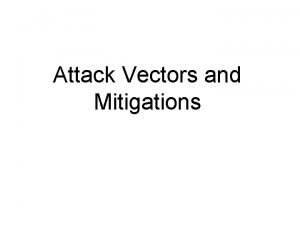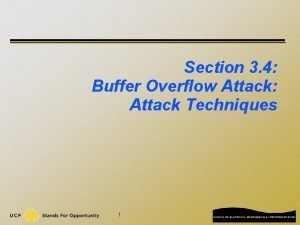THE INFLUENCE OF THE ATTACK TEMPO ON THE


















- Slides: 18

THE INFLUENCE OF THE ATTACK TEMPO ON THE TYPE OF BLOCK IN HIGH-LEVEL MEN’S VOLLEYBALL Raúl Hileno, Cristòfol Salas, & Bernat Buscà 1

INTRODUCTION Attack tempo is the elapsed time between the setting touch and the attack hit (Fernández, Salas, & Molina, 2009). Fernández, M. , Salas, C. , & Molina, J. J. (2009). Technical and tactical variations in the blocking of zero attacks considering contextual variables: the influence of the scoreboard in volleyball. Kronos, 8(14), 71– 78. 2

INTRODUCTION Attack tempo is one of the main variables in the game because it’s a determinant factor for the block cohesiveness and the attack efficacy (Afonso & Mesquita, 2011). Afonso, J. , & Mesquita, I. (2011). Determinants of block cohesiveness and attack efficacy in high-level women’s volleyball. European Journal of Sport Science, 11(1), 69– 75. 3

INTRODUCTION Data Volley System (Data Project, Bologna, Italy, release 3. 4. 2) includes attack tempo in its category system. Attack tempo 4

INTRODUCTION The different user manuals of this software unclear with the criteria to distinguish quick, fast, and high attacks. 5

INTRODUCTION Fernández et al. (2009) propose three criteria to define the attack tempo categories: 3) thetrajectory interaction(maximum between and block. 2) Observe the relationship betweenattack set and 1) Examine Control the height) ofattack. the setting pass. Fernández, M. , Salas, C. , & Molina, J. J. (2009). Technical and tactical variations in the blocking of zero attacks considering contextual variables: the influence of the scoreboard in volleyball. Kronos, 8(14), 71– 78. 6

INTRODUCTION The purpose of the present study was to analyse the relationship between attack tempo and type of block in high-level men’s volleyball. Thus, we expected to determine: 1) The time intervals when the different types of block are significantly formed. 2) A temporal threshold to differentiate fast and high attacks of the outside hitters. 7

METHODS Observational design Type of data Idiographic Event-base Punctual Sequential Concurrent I Event II Multi-event T 12 T 18 T 14 T 04 … DB. HB. Follow-up Time-base III IV State/Interval Timed-event F/N/M Nomothetic Blanco, A. , Losada, J. L. , & Anguera, M. T. (2003). Data analysis techniques in observational designs applied to the environmentbehaviour relation. Medio Ambiente y Comportamiento Humano, 4(2), 111– 126. Bakeman, R. , & Gottman, J. M. (1992). Observing interaction: an introduction to sequential analysis. Cambridge, UK: Cambridge University Press. 8

METHODS Participants • 15 volleyball matches (57 sets) from the 2010 Men’s Pan. American Cup held in San Juan (Puerto Rico). • 9 national teams: Argentina, Brazil, Canada, Colombia, Dominican Republic, Mexico, Puerto Rico, USA, and Venezuela. • 1451 multi-events (attack-block interactions). 9

METHODS Observational instrument 1) Attack tempo = 21 categories: 0. 2 to 2. 2 s. 2) Type of block = 5 categories (Data Volley System): No block Single Hole Double Triple 10

METHODS Procedures and material The matches were recorded using a digital camcorder (JVC Everio GZ-MG 630) at 25 FPS. 11

METHODS Procedures and material Frame-by-frame analysis was performed using Kinovea video analysis software (Charmant & Contrib. , Bordeaux, France, release 0. 8. 15). 12

METHODS Procedures and material Multi-events were recorded using MS Excel 2007 and were analysed using SDIS-GSEQ statistical software (Bakeman & Quera, Atlanta, GA, EUA, release 5. 1). 13

METHODS Statistical analysis • The adjusted residual for each cell of the contingency table was computed. A z-score greater than 1. 96 indicated that the relationship between • The relationship between attack a given and a target category was tempo and type of block criteria was significant. assessed using Pearson’s chi-square tests for independence. Statistical significance was set at P < 0. 05. 14

RESULTS • There was a relationship between attack tempo and type of block criteria ( 2 = 718. 50, P < 0. 01). • Twenty-two significant relationships were found between the given and the target categories (Z > 1. 96, P < 0. 05): 0. 4, 0. 8 – 0. 9 s No block 0. 2 – 0. 9 s 1. 0 – 1. 2 s 1. 3 – 1. 8 s 1. 6 – 1. 8 s Single Hole Double Triple 15

DISCUSSION Quick attacks of the middle hitters: 0. 3 – 0. 5 s Fast attacks of the outside hitters: 0. 6 – 1. 2 s High attacks of the outside hitters: 1. 3 s onwards (Selinger & Ackermann-Blount, 1992) (Selinger & Ackermann-Blount, 1992; Zimmermanm, 1993) (Zimmermanm, 1993) No block Single Hole Double Triple Non-cohesive blocks + jump settings in ideal zones Cohesive blocks + settings in non- + attack simulations by the middle hitters ideal zones + non-simulations by the (Afonso, Mesquita, Marcelino, & Da Silva, 2010) middle hitters (Afonso et al. , 2010) Afonso, J. , Mesquita, I. , Marcelino, R. , & Da Silva, J. A. (2010). Analysis of the setter’s tactical action in high-performance women’s volleyball. Kinesiology, 42(1), 82– 89. Selinger, A. , & Ackermann-Blount, J. (1992). Power volleyball. Paris: Vigot. Zimmermann, B. (1993). Main characteristics of defense (block, court defense, counterattack) in top volleyball. International Volley Tech, 1(93), 9– 16. 16

CONCLUSIONS Cohesive blocks Non-cohesive blocks No-block Single Hole Double Triple Quick/Fast attacks High attacks 0. 2 – 1. 2 s 1. 3 s onwards Temporal threshold 17

THANKS FOR YOUR ATTENTION Raúl Hileno, Cristòfol Salas, & Bernat Buscà THE INFLUENCE OF THE ATTACK TEMPO ON THE TYPE OF BLOCK IN HIGH-LEVEL MEN’S VOLLEYBALL 18
 Active attack and passive attack
Active attack and passive attack Passive attack and active attack
Passive attack and active attack As vezes perdemos
As vezes perdemos Arrume tempo para quem tem tempo pra você
Arrume tempo para quem tem tempo pra você Khi nào hổ con có thể sống độc lập
Khi nào hổ con có thể sống độc lập Thế nào là mạng điện lắp đặt kiểu nổi
Thế nào là mạng điện lắp đặt kiểu nổi Các châu lục và đại dương trên thế giới
Các châu lục và đại dương trên thế giới Dot
Dot Biện pháp chống mỏi cơ
Biện pháp chống mỏi cơ Bổ thể
Bổ thể độ dài liên kết
độ dài liên kết Thiếu nhi thế giới liên hoan
Thiếu nhi thế giới liên hoan điện thế nghỉ
điện thế nghỉ Vẽ hình chiếu vuông góc của vật thể sau
Vẽ hình chiếu vuông góc của vật thể sau Alleluia hat len nguoi oi
Alleluia hat len nguoi oi Một số thể thơ truyền thống
Một số thể thơ truyền thống Trời xanh đây là của chúng ta thể thơ
Trời xanh đây là của chúng ta thể thơ Sơ đồ cơ thể người
Sơ đồ cơ thể người Công thức tiính động năng
Công thức tiính động năng



































